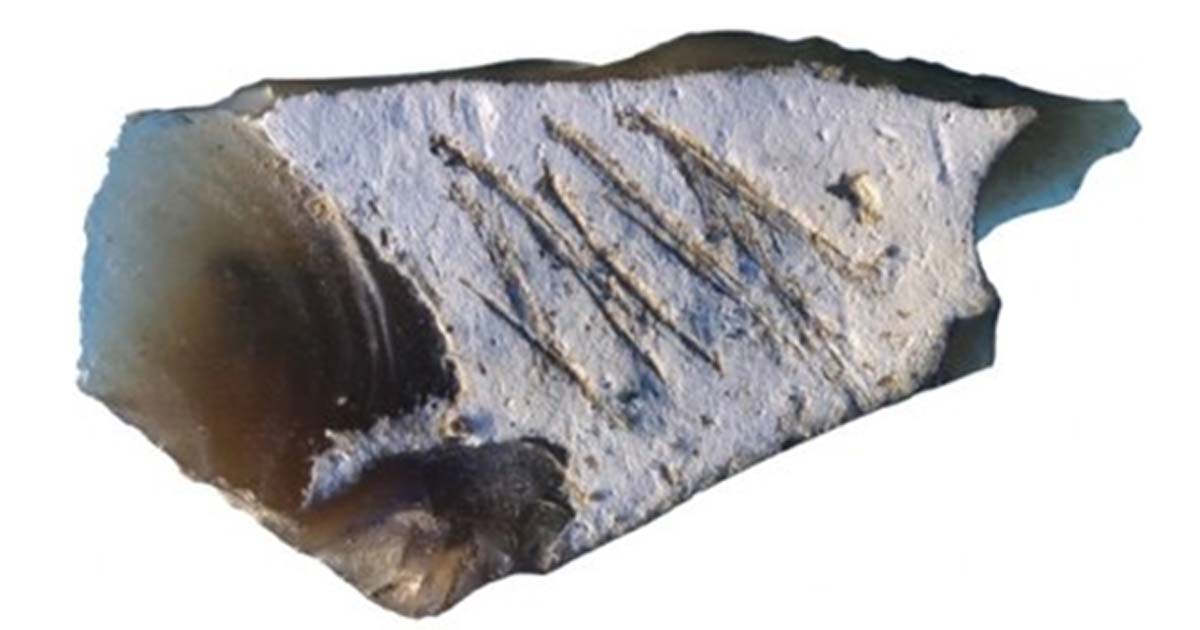Engraved Crimean Stone Artifact May Demonstrate Neanderthal Symbolism
A flint flake from the Middle Paleolithic of Crimea was likely engraved symbolically by a skilled Neanderthal hand, according to a study published May 2, 2018 in the open-access journal PLOS ONE by Ana Majkic from the University of Bordeaux, France and colleagues. The authors developed a detailed framework for interpreting engravings on stone artifacts.
A Telling Action
Engraved stone artifacts are important clues to the history of human culture and cognition. Incisions on the cortex (soft outer layer) of flint or chert flakes are known from Middle and Lower Paleolithic sites across Europe and the Middle East. However, it can be difficult to determine the action that created an incision: was it an accidental scrape or purposeful engraving? To address this issue, Majkic and colleagues created an interpretive framework that allows researchers to classify the structure and patterns of engraved cortexes and cross-check these attributes with a list of possible causal actions.
- More Than 70 Engravings and Paintings from 14,000 Years Ago Discovered in a Spanish Cave
- 8,000-Year-Old Engravings in Arabian Desert Are Oldest Known Depictions of Dogs on Leashes
- Australian Original Astronomical rock Engravings will Rewrite World History

The new methodology hopes to establish the causal actions of such markings as found on this flint from Kiik Koba. Image: Majkic et al (2018)/ (CC BY 4.0)
They tested this methodology with an engraved flake from the cave site of Kiik-Koba in Crimea. The many stone artifacts at the site are associated with Neanderthal remains and date to around 35,000 years ago. Following microscopic examination of the grooved lines on the flint cortex, the researchers concluded that the incisions represent deliberate engravings that would have required fine motor skills and attention to detail. These engravings appear to have been made with symbolic or communicative intent.

Photo (top) and tracing (bottom) of engraved flint flake. Engraved lines are indicated by dark-grey areas outlined in black, surface damage by light gray areas, flake scars by gray lines.Image: Majkic et al (2018)/ (CC BY 4.0)
If this interpretation is correct, this engraved flake would join a growing list of signs that Neanderthals engaged in symbolic activities, along with evidence of intentional burial, personal ornaments, and other decorated objects. This has implications for the question of when and how many times this sort of cultural expression has evolved among hominin populations. The researchers hope to hone their framework further for use with artifacts of varying ages and cultural contexts.
- Prehistoric Britons Cannibalized Dead Relatives and Created Art with their Bones
- 14,500-Year-Old Stone Engravings: Archaeologists Uncover Earliest Known Art in Britain
- Rock Art Rituals: Namib Desert Engravings Provide Fascinating Insight into Ancient Initiation for Girls
Further Application of the Methodology
One such artifact might be the intriguing scratching on a fossilized Pseudodon shell found in Java. This has what seems to be manmade markings on it, which are in a regular zigzag pattern similar to the marking on the flint flake.

This etched shell from Java was found at the site where Homo erectus was discovered. Credit: Wim Lustenhouwer/VU University Amsterdam
This shell is 500000 years old and it is believed these marks were made by Homo erectus. The new methodology could help discover if these markings are human made and maybe provide insights furthering our understanding of the many ancient zigzag engravings that are the oldest examples of humans leaving their mark on the word by use of hand (presumably) and implement.
Top image: Engraving found in Crimean cave on flint flake from Kiik-Koba layer IV. Source: Majkic et al (2018)/ (CC BY 4.0)
The article ‘Engraved Crimean Stone Artifact May Demonstrate Neanderthal Symbolism,’ was originally published on Science Daily.
Source: PLOS. "Engraved Crimean stone artifact may demonstrate Neanderthal symbolism: New framework aids interpretation of engravings on stone artifacts." ScienceDaily. ScienceDaily, 2 May 2018. www.sciencedaily.com/releases/2018/05/180502174928.htm
Reference:
Ana Majkić, Francesco d’Errico, Vadim Stepanchuk. Assessing the significance of Palaeolithic engraved cortexes. A case study from the Mousterian site of Kiik-Koba, Crimea. PLOS ONE, 2018; 13 (5): e0195049 DOI: 10.1371/journal.pone.0195049



















